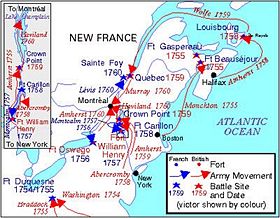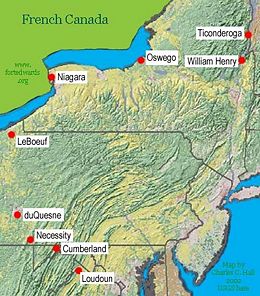French And Indian War
 From Conservapedia
From Conservapedia The French and Indian War, was the North American phase of the Seven Years War in Europe. It was a war fought between Britain and France from 1754 to 1760 in territory that became Canada and the United States. Native Americans fought for both sides, although mainly on the side of the French. The British were victorious, ending France's control of Canada and the Mississippi Valley. Spain was granted Louisiana as compensation for the loss of Florida. The war was officially ended with the signing of the Treaty of Paris in 1763.

Contents
- 1 Name
- 2 Soldiers
- 3 Battles
- 3.1 Braddock's defeat
- 3.2 Massacre
- 3.3 Victory
- 4 Indians
- 5 Impact of war
- 5.1 Memory
- 6 See also
- 7 Further reading
- 7.1 Advanced topics
- 7.1.1 Notes
- 7.1 Advanced topics
Name[edit]
The war is called the French and Indian War because the British army and the American colonials fought against the French army and its Indian allies. A few Indians fought on the British side. French Canadians call it the "War of the Conquest." Europeans call it the "Seven Years War" because it lasted 1756-1763. Most of the war was fought in Europe. There had been a series of "French and Indian" wars since 1690, and this was the last and most important of them.
Soldiers[edit]
British prime minister William Pitt the elder decided that it was necessary to win the war against France at all costs. In previous wars America had been a side-show to Europe; now it was an important arena, though still not as important as central Europe. Militia and volunteers from the Thirteen Colonies became the main source of British manpower, augmented by British regiments and under the command of British professional soldiers. Most of the Americans were young and poor; many were indentured servants who won freedom from their labor contracts by going to war.
In Pennsylvania, Benjamin Franklin played a crucial role in organizing the defense of the colony over the objections of thepacifistic Quakers. Franklin tried but failed to get the Thirteen Colonies to unite through the proposed Albany Plan of Union.
Battles[edit]

Braddock's defeat[edit]
The war began when British troops under General Edward Braddock on their way to oust the French from Fort Duquesne (modern Pittsburgh) in 1755 were ambushed and defeated by French troops and their Indian allies at the battle of the Wilderness. Virginia colonel George Washington took over when Braddock was killed and led a successful retreat back to Virginia.

Washington's military experiences throughout the Ohio country during the French and Indian War prepared him to effectively manage logistical problems, strategic planning, troop morale and discipline, and ineffectual decisionmaking by elected officials during the American Revolution.
Braddock defeat showed the great disadvantage professional British soldiers had in fighting Indian warriors in the woods. The British adjusted to American conditions by recruiting Indian allies and American backwoodsmen to serve as rangers, and attempting to train British soldiers in American fighting conditions. The number of American rangers steadily expanded during the French and Indian War. Lieutenant-Colonel Thomas Gage's 80th Regiment of Light Armed Foot in 1758 began a trend in establishing units better suited for American conditions. In 1759, light companies were formed in all the regular battalions in North America. By the war's end British troops in America had become efficient in irregular warfare and stood apart from other British units.[1]
Massacre[edit]
The French and their Indian allies forced the surrender of the British at Fort William Henry in upstate New York in 1757. The garrison surrendered to French commander Louis-Joseph de Montcalm-Gozon (1712–59) but he failed to enforce the articles of capitulation that obliged him to protect his prisoners from the wrath of his Indian allies. The Indians massacred most of the prisoners and took home their scalps as trophies. Several of the prisoners had smallpox, and the scalps infected and killed hundreds of Indians in the following weeks.
Victory[edit]

The most famous battle was the British victory in 1759 during the siege of Quebec. General Marquis de Montcalm led French forces, and General James Wolfe led British troops. Both Montcalm and Wolfe died in the fight.
Indians[edit]
Indian warriors' played a major role in alliance with the French to attack the American backcountry of Virginia and Pennsylvania from 1754 to 1758. The French and Canadians supplied their Indian allies from the Susquehanna and Ohio valleys to neutralize colonial Anglo-American military power during the larger Seven Years' War. But the warriors - chiefly Potawatomis and Ottawas - fought for their own goals and devised tactics for their own aims. Although the Indians depended on French supplies, they were not united as one people under explicit loyalty to French leadership. During 1754-58, the Indians successfully paralyzed the two colonies, and these four years of war present a complex picture of Indian groups. Individual groups of Indians had various motives, used strategies adapted to political aims as well as warfare, and waged battles devised to affect truces and alliances with whites and other Indians. Frontier warfare declined throughout 1758, not because Anglo-American forces defeated Indian war parties or the French, but because the French were unable to supply their Indian allies.[2]
Impact of war[edit]
The war also increased a sense of American unity. It brought men from different colonies together for the first time. British officers trained American ones (most notably George Washington). Legislatures and officials of the American colonies had to cooperate intensively, for the first time, in pursuit of the continent-wide military effort.
The British and colonists triumphed jointly over a common foe. The colonists' loyalty to Britain grew stronger. However, trouble was forming. With France gone, the Americans no longer needed the protection of the British. The British paid for an expensive war and decided their rich colonies should pay part of the cost through taxes. They did not consult Americans on the matter, and this led to increasingly strong protests and finally the American Revolution in 1775. The British furthermore felt colonists' poor discipline made them inferior soldiers and thus had an exaggerated view of the power of the British army to compel the Americans to obey London.
Memory[edit]

In 2009 Quebec nationalists vetoed plans for a reenactment of the 1759 battle at Quebec, sayting the defeat was a humiliation they did not wish to commemorate.
In his great novel The Last of the Mohicans (1826), James Fenimore Cooper used a historical setting and relied heavily on historical documents. Cooper's fiction strayed little from his sources on historical incidents in 1757 during the French and Indian War. He did invent some contextual features. Cooper resorted to artistic judgments when his sources were inadequate, but his porytrayals were highly realistic.[3]
See also[edit]
- Rogers' Rangers
Further reading[edit]
- The Canadian Encyclopedia (2008) good short articles
- The Dictionary of Canadian Biography(1966-2006), scholarly biographies of every major British and Canadian participant
- Anderson, Fred. Crucible of War: The Seven Years' War and the Fate of Empire in British North America, 1754-1766 (2000), 887pp; the standard scholarly study excerpt and text search
- Anderson, Fred. The War That Made America: A Short History of the French and Indian War (2006), abridged edition excerpt and text search, a good starting point
- Borneman, Walter R. The French and Indian War: Deciding the Fate of North America (2007) excerpt and text search
- Cave, Alfred A. The French and Indian War (2004), short overview by leading scholar online edition
- Leckie, Robert. "A Few Acres of Snow": The Saga of the French and Indian Wars. (1999). 388 pp. popular history
Advanced topics[edit]
- Brecher, Frank W. Losing a Continent: France's North American Policy, 1753-1763 (1998) online edition
- Brumwell, Stephen. Redcoats: The British Soldier and War in the Americas, 1755-1763. (2002). 349 pp.
- Corbett, Julian. England in the Seven Years' War: A Study in Combined Operations (2 vol, 1918); classic history. vol 1 online* Higonnet, Patrice. "The Origins of the Seven Years' War," Journal of Modern History 40 (1968). Americans started it.
- Ferling, John. "The New England Soldier," American Quarterly 33 (1981) 26-45 in JSTOR
- Freeman, Douglas Southall. George Washington. A Biography (1948) vol 1. Pulitzer prize
- Nester, William R. The First Global War: Britain, France, and the Fate of North America, 1756-1775. (2000) 320 pp. online edition
- Nicolai, Martin L. "A Different Kind of Courage: The French Military and the Canadian Irregular Soldier during the Seven Years' War," Canadian Historical Review 70 (1989). 53-75
- Parkman, Francis. Montcalm and Wolfe: The French and Indian War. (1884), famous narrative by leading historian; liberals strongly dislike its conservative tone full text online
- Schwartz, Seymour I. The French and Indian War, 1754-1763 (1995), encyclopedia
- Selesky, Harold E. War and Society in Colonial Connecticut (1990); who comprised the militia. & how they fought
- Steele, Ian. Guerrillas and Grenadiers: The Struggle for Canada, 1689-1760 (1969); war won by conventional European-style battles and sieges. not skirmishes in woods
- Titus, James. The Old Dominion at War: Society, Politics, and Warfare in Late Colonial Virginia. (1991). 213 pp.
Notes[edit]
- ↑ Steve Brunwell, "'A Service Truly Critical': The British Army and Warfare with the North American Indians, 1755-1764." War in History 1998 5(2): 146-175. 0968-3445
- ↑ Matthew C. Ward, "Fighting The 'Old Women': Indian Strategy on the Virginia and Pennsylvania Frontier, 1754-1758." Virginia Magazine of History and Biography 1995 103(3): 297-320. 0042-6636
- ↑ Ian K. Steele, "Cooper and Clio: The Sources for 'A Narrative Of 1757.'" Canadian Review Of American Studies 1989 20(3): 121-135.
Categories: [Wars] [Colonial America] [Canadian History]
↧ Download as ZWI file | Last modified: 03/10/2023 21:24:55 | 16 views
☰ Source: https://www.conservapedia.com/French_and_Indian_War | License: CC BY-SA 3.0
 ZWI signed:
ZWI signed: KSF
KSF